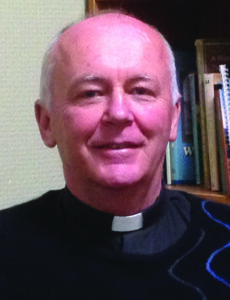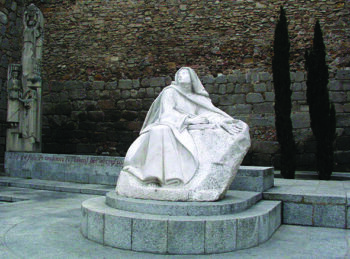The Prayer Journey According to St Teresa of Ávila
This article and the ones that follow are designed to help you to read the very inspiring actual words of St Teresa of Ávila on prayer. I hope to give you greater access to what she wrote if you are not familiar with her writings.
St Teresa wrote three great masterpieces:
• The Life, 1562, with a revised edition in 1565;
• The Way of Perfection, 1566-7; and
• The Interior Castle, 1577.
These works are readily available online, from Pleroma Christian Supplies in NZ, and from Pauline Books and Media in Australia and the USA.
These are the books that contain her essential teaching about prayer. This article, and those that follow in the Messenger, will give an introduction and guide to them, but especially to the greatest, The Interior Castle.
The Life and its teaching on prayer
1] This first work is her autobiography, but with a difference. It could be called a spiritual testimony. It is the story of St Teresa’s prayer journey, or, as she would say, of God’s desire to give her the gift of prayer. That is part of its continual relevance. Her teaching on prayer is the fruit of her hard-won experience of responding to God’s love.
She does not preach to us, nor tell us as an expert on prayer, which she is in truth, but in humility, she recounts her struggles to pray. She is very reassuring for the struggling beginner, which we all are. That is comforting. So, the first reason to read The Life is that it is real; it tells of her efforts to live a life of prayer, her ups and downs, and her ultimate conversion to be a woman of deep prayer. She says in The Life, “God has been very good to me”.
2] It is worth noting that by 1562 St Teresa had had very mature experience of prayer. She was forty-seven years of age, and was inspired by the Holy Spirit to write and reflect on her experience, a gift that she received from the Lord, an ecclesial charism -- for the rest of us in the Church. In fact, it was not written for publication. There was no vanity in her, but at the request of her confessors, she told of what happened to her in prayer, while being aware that there are many paths to God. She wrote of what God had taught her. So, The Life is the Holy Spirit helping her make sense of what had happened to her in prayer. She looked back, and thanks to the Holy Spirit, began to understand her prayer experience, that it might help others.
3] Within this masterpiece there are many insights about prayer – for example, her teaching on the four types of prayer, “the four waters”.
In Chapters 11 to 21, she explains the four types of prayer, the four steps to God. St Teresa compares our soul to a watered garden -- important in the Spanish climate, especially in Castile. She calls them the “four watering systems”, or the “four methods by which the garden may be watered”.
‘Water’ means God’s presence and grace. As she writes, “Oh, how many times do I recall the living water that the Lord told the Samaritan woman about”. Water flows and makes plants –- virtues -- grow. She writes, “The beginner must think of themselves as of one setting to make a garden in which the Lord is to take his delight, yet in soil most unfruitful and full of abominable weeds” (Chapter 11).
St Teresa did not say this is the only way, but wrote, under obedience, so that her Carmelite sisters might be helped in their prayer lives. The Reform of the Carmelite Order was totally dependent on deeply prayerful women. Once prayerfulness is in place, all is essentially well. She writes, “Do you know how clean this water is, this heavenly water, this clear water … Once this water has been drunk, I am certain that it leaves the soul bright and cleansed of all faults”.
4] The first water of prayer [The Life, chapters 11-13] is described as watering the garden with a bucket by hand, lots of hard work. We go to the well, put down the bucket, draw it up and bring the water back to the garden. So, in our lives, it means that we take time for prayer, put the cell phone on mute, get our prayer books out, read and reflect. We are conscious of what we do. We could call this active prayer. Note that the garden has been weeded of sins. We need determination to keep using this way of watering the garden. As St Teresa writes, “They must have a great and very resolute determination to persevere”.
5] The second water [The Life, chapters 14-15] is using a water wheel -- not so well known to us -- a water wheel with dippers attached. As the wheel turns, and it seems the wheel needs to be turned by hand, the dippers pour the water into a trench which in turn carries the water to the garden.
So, after much effort with the hand-drawn bucket, prayer begins to change. Here, by means of buckets filled with a windlass, more water is brought to the garden, so saving the labour-intensive work of the first efforts at prayer. Yes, prayer still comes from the well, but we have more help -- mechancial assistance, to use her example. Prayer feels easier. She calls this the prayer of quiet, as we are feeling more peaceful and calm inside, meaning that our relationship with the Lord is maturing, and we are given over to his Will. This is a gift. So she writes, “The Lord desires us to recognise our uselessness and become like little donkeys that turn the waterwheel”.
6] The third water [The Life, chapters 16-17] is watering of the garden by a stream or a brook. The Lord Himself takes over the watering of the garden through irrigation. This is a deeper form of the second water, with deeper connection with God. God takes more of the initiative. Now the water will never run dry. God will always provide this living water for our soul. He provides an endless source of water. God is largely the gardener here. The person praying is very aware of God’s and others’ presence. So, she writes, ”O blessed souls ... help us, since you are so near the fount, draw water for those here below who are perishing”.
7] The fourth water [The Life, chapters 18-21] is the rain that waters the garden, the falling of rain on the garden. What a beautiful image to describe the gift of this deep prayer. St Teresa found it challenging to write of this fourth water, as it was so deep, and she admits she did not have the language. St Teresa had just received this type of intimate union with God in prayer when she wrote the Life. This is deep intimacy with God. Compared to the first prayer, we are conscious of God’s work in us rather than of our efforts. The persons praying are no longer concerned about themselves, but rather about the Lord who dwells within them. It is like being possessed by God. It is worth noting, that at the same time, the person praying is very humbled by this experience. It is a terrible thing to fall into the hands of the living God! The person praying knows deeply the sheer gift of it and finds it difficult to even tell their spiritual director. If there is pride and self-satisfaction, it is not the 4th degree of prayer! Of course, after this prayer St Teresa is even more on fire with zeal, and continues founding Carmelite monasteries all over Spain. There is a real link between this prayer and her activity for God. It was the busiest time in her life. She had bad health, but God was never more alive in her. Now, whatever she does comes from a deep divine source within her. The rain of God’s love and presence was falling.




 Entries(RSS)
Entries(RSS)